Palmistry Chiromancy
Chiromancy or 'cheiromancy', is the art of characterization and
foretelling the future through the study of the palm, also known as
palmistry, palm-reading, chirology or hand analysis. The practice is
found all over the world, with numerous cultural variations. Those who
practice chiromancy are generally called palmists, palm readers, hand
readers, or chirologists.
Palmistry can trace its roots back to Indian (Hindu) Astrology (known in
Sanskrit as Jyotish) and Roma (gypsy) fortune tellers. The Hindu sage
Valmiki is thought to have written a book, whose title translates in
English as "The Teachings of Valmiki Maharshi on Male Palmistry",
comprising 567 stanzas, more than 5,000 years ago.
From India, the art of palmistry spread to China, Tibet, Egypt, Persia
and to other countries in Europe. Palmistry came to China in around
3,000 B.C. It then progressed to Greece where Anaxagoras practized it.
However, modern palmists often combine traditional predictive techniques
with psychology, holistic healing, and alternative methods of
divination.
The practice of chiromancy is generally regarded as a pseudoscience. It
should be noted that the information outlined below is briefly
representative of modern palmistry; there are many, often conflicting,
interpretations of various lines and palmar features across various
"schools" of palmistry.
Chiromancy consists of the practice of evaluating a person's character
or future by "reading" the palm of that person's hand. Various "lines"
("heart line", "life line", etc.) and "mounts" (or bumps) (chirognomy),
purportedly suggest interpretations by their relative sizes, qualities,
and intersections. In some traditions, readers also examine
characteristics of the fingers, fingernails, fingerprints and palmar
skin patterns (dermatoglyphics), skin texture and color, shape of the
palm, and flexibility of the hand.
A palm reader usually begins by reading the person's 'dominant hand'
(the hand he or she writes with or uses the most). In some traditions of
palmistry, the other hand is believed to carry past-life or karmic
information, as well as hereditary traits which is not the case. One
lines form on the palm they remain there. New lines are created as a
person experiences life.
Chiromancy consists of the practice of evaluating a person's character
or future life by "reading" the palm of that person's hand. Various
"lines" ("heart line", "life line", etc.) and "mounts" , purportedly
suggest interpretations by their relative sizes, qualities, and
intersections. In some traditions, readers also examine characteristics
of the fingers, fingernails, fingerprints and palmar skin patterns
(dermatoglyphics), skin texture and color, shape of the palm, and
flexibility of the hand.
A reader usually begins by reading the person's 'dominant hand' (the
hand he or she writes with or uses the most)(sometimes considered to
represent the conscious mind, whereas the other hand is subconscious).
In some traditions of palmistry, the other hand is believed to carry
hereditary or family traits, or, depending on the palmist's cosmological
beliefs, to convey information about past-life or karmic conditions.
The basic framework for "Classical" palmistry (the most widely taught
and practiced tradition) is rooted in Greek mythology. Each area of the
palm and fingers is related to a god or goddess, and the features of
that area indicate the nature of the corresponding aspect of the
subject. For example, the ring finger is associated with the Greek god
Apollo; characteristics of the ring finger are tied to the subject's
dealings with art, music, aesthetics, fame, wealth, and harmony.
History of Palmistry

Palmistry is an ancient practice that can be found dating back thousands
of years. The prehistoric caves in France and Spain display hand
drawings of palms with the major lines portrayed in amazing detail.
Judging by the number of hands painted in prehistoric caves it would
seem the human hand held a interest for humans since the stone age.
Archaeological discoveries have discovered hands made of stone, wood and
ivory by ancient civilizations. The use of the palm of the hand as a
tool for healing, a link between man and god, as been repeated over and
over again in history.
Palmistry can trace its roots back to India in (Hindu) Astrology (known
in Sanskrit as Jyotish), Chinese Yijing (I Ching), and Roma (Gypsy)
fortune tellers. The Hindu sage Valmiki is thought to have written a
book, whose title translates in English as "The Teachings of Valmiki
Maharshi on Male Palmistry", comprising 567 stanzas. From India, the art
of palmistry spread to China, Tibet, Egypt, Persia and to other
countries in Europe From China, palmistry progressed to Greece where
Anaxagoras practiced it. However, modern palmists often combine
traditional predictive techniques with psychology, holistic healing, as
well as alternative methods of divination.
The basic framework for Classical Palmistry (the most widely taught and
practiced tradition) is rooted in Greek mythology. Each area of the palm
and fingers is related to a god or goddess, and the features of that
area indicate the nature of the corresponding aspect of the subject. For
example, the ring finger is associated with the Greek god Apollo;
characteristics of the ring finger are tied to the subject's dealings
with art, music, aesthetics, fame, and harmony. Aristotle (384-322 b.c)
discovered a treatise on Palmistry on an altar to the god Hermes. The
Greek physicians Hippocrates and Galen (ad 130-200) were both
knowledgeable about the use of palmistry as a clinical aid.
The emperor of China used his thumbprint when sealing documents in 3000
BC. Information on the laws and practice of hand reading have been found
in Vedic scripts, the bible and early Semitic writings.
The ancient Vedas, the earliest sacred Hindu writings, studied the hands
as a means to unveil and understand the self and relationships with
others. Here began an understanding that the unique patterns of lines
and signs in the hand are a direct result of the way we think -
consciousness creating the human blueprint for experience.
Julius Caesar is said to have judged his men by palmistry.
An early writing using the word Palmistry - spelled 'Pawmestry' - was written in 1420 by John Lyndgate in his Assembly of Gods documents.
The first book on Palmistry was Michael Scotts De Philsiognomia written in 1477 on the physiognomy of the human body with a chapter on all the aspects of the human hand. He wrote, Just as a pebble thrown into the water creates ripples, so our thoughts create similar effects on our palms.
In the seventeenth century many books were written that included the
early gypsy ideas about the hand that had been handed down through
tradition since the early 1400s.
The practice of palmistry was unfortunately forced underground by the Catholic Church who branded it devil worshiping.
By the eighteenth century books were written blending some scientific
information about the hand with mysticism. Since then Palmistry was
aligned with the idea that a person read the hand with a scientific eye
and spoke from intuition. Palmistry then was a form of prediction that
was as individual as the hand.
And so evolved the gypsy fortune teller as the hand of hate created the 18th century grid experiences for humanity.
Marie Anne le Norman was a famous French fortune teller in Napoleon's
court who created great interest in Palmistry because of her predictive
successes with Napoleon and Josephine. Two other Frenchmen DArpentigny
born in 1798 and Desbarrolles born in 1801 wrote on the subject.
Dr Carl Carus, physician to the king of Saxony in the 19th century matched palms to personality.
Patrick "The Mysterious" Goodden, was said to be able to predict
someone's exact date of death by looking at someone's hand. He died in
1875 and ironically predicted the completely wrong day of death.
Alex "The Mighty" Bernas, it has been said, could not only predict date
of death but also the cause of death. He was known to heal as well and
was not only revered as a chiromancer but also a witch doctor.
Cheiro, as he is known by nickname, was said to have predicted correctly
dates and events in the lives of many renowned celebrities, including
Marilyn Monroe, and even his own death.
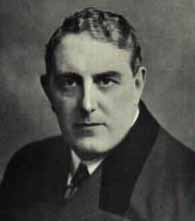
Cheiro (1866-1936), was one of the most famous and colorful occult
figures of the early Twentieth Century, Cheiro was a clairvoyant who
used palmistry (or cheiromancy), astrology, and Chaldean numerology, to
make startlingly accurate predictions, including world events. Born in
Ireland as William John Warner, Cheiro also went by the name Count Louis
Hamon, claiming a noble ancestry that may or may not have been
accurate. His name, Cheiro, derives from the word cheiromancy.
There has always been skepticism about palmistry. Yet in the 21st
century people study the lines on the hands with children born with
various challenges such as autism, Downs Syndrome, ADD, among others.
There often is a correlation which one day may help in early diagnosis
of childhood illnesses which go undetected in early childhood.
As we came to study the lines on the fingers as a personal blueprint of
signature for an individual, forensic research would determine that
fingerprints were unique to each individual.
In 1901 Scotland Yard adopted the technique of fingerprinting in
criminal investigation and identification. Fingerprint identification is
sometimes referred to as dactyloscopy. It involves the process
of comparing questioned and known friction skin ridge impressions from
fingers, palms, and toes to determine if the impressions are from the
same finger. The flexibility of friction ridge skin means that no two
finger or palm prints are ever exactly alike even two impressions
recorded immediately after each other. Fingerprint identification occurs
when an expert (or an expert computer system operating under threshold
scoring rules) determines that two friction ridge impressions originated
from the same finger or palm (or toe, sole) to the exclusion of all
others.
Medical researchers studying skin patterns - Dermatoglyphics - have
discovered a correspondence between genetic abnormalities and unusual
markings in the hand. Research has confirmed a link between specific
fingerprint patterns and heart disease.
Hand Shapes
Though there are debates on which hand is better to read from, both have
their own significance. It is custom to assume that the left hands
shows potential in an individual, and the right showed realized
personality. Some sayings about the significance include "The future is
shown in the right, the past in the left"; "The left hand is the one we
are born with, and the right is what we have made of it"; "The right
hand is read for men, while the left is read for women"; "The left is
what the gods give you, the right is what you do with it." The choice of
hand to read is ultimately up to the instinct and experience of the
practitioner.
- The Left Hand is controlled by the right brain (pattern
recognition, relationship understanding), reflects the inner person, the
natural self, the anima, and the lateral thinking. It could even be
considered to be a part of a person spiritual and personal development.
It is the "yin" of personality (feminine and receptive).
- The Right Hand is controlled by the left brain
(logic, reason, and language), reflects the outer person, objective
self, influence of social environment, education, and experience. It
represents linear thinking. It also corresponds to the "yang" aspect of
personality (masculine and outgoing).
Depending on the type of palmistry practiced, and the type of reading
being performed, palmists may look at various qualities of the hand,
including the shapes and lines of the palm and fingers; the color and
texture of the skin and fingernails; the relative sizes of the palm and
fingers; the prominence of the knuckles; and numerous other attributes
of the hands.
In most schools of palmistry, hand shapes are divided into four or 10
major types, sometimes corresponding to the Classical elements or
temperaments. Hand shape is believed to indicate character traits
corresponding to the type indicated (i.e., a "Fire hand" would exhibit
high energy, creativity, short temper, ambition, etc. - all qualities
believed to be related to the Classical element of Fire).
Although variations abound, the most common classifications used by modern palmists:
- Earth hands are generally identified by broad, square palms
and fingers, thick or coarse skin, and ruddy color. The length of the
palm from wrist to the bottom of the fingers is usually equal to the
length of the fingers.
- Air hands exhibit square or rectangular palms with
long fingers and sometimes protruding knuckles, low-set thumbs, and
often dry skin. The length of the palm from wrist to the bottom of the
fingers is usually equal to the length of the fingers.
- Water hands are seeable by the short, sometimes
oval-shaped palm, with long, flexible, conical fingers. The length of
the palm from wrist to the bottom of the fingers is usually less than
the width across the widest part of the palm, and usually equal to the
length of the fingers.
- Fire hands are characterized by a square or
rectangular palm, flushed or pink skin, and shorter fingers. The length
of the palm from wrist to the bottom of the fingers is usually greater
than the length of the fingers.
The number and quality of lines can also be included in the hand shape
analysis; in some traditions of palmistry, Earth and Water hands tend to
have fewer, deeper lines, while Air and Fire hands are more likely to
show more lines with less clear definition.
Lines
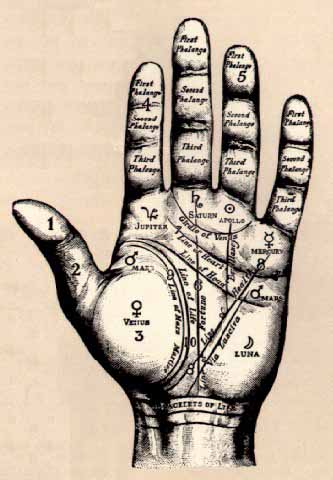
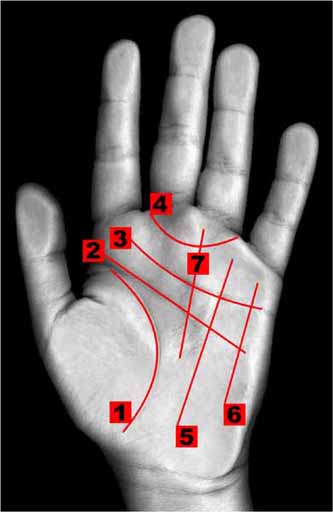
1: Life Line
2: Head Line (Education)
3: Heart Line (Marriage, Relationships)
4: Girdle of Venus (Empath)
5: Girdle of Venus in the shape of a "V" (Homosexual)
6: Sun (Apollo) Line (Creative, Metaphysics, Health)
7: Mercury Line (Communication, Travel)
8: Fate (Career) Line - Goes from the Wrist Upward)
The three lines found on almost all hands, and generally given most weight by palmists:
- The heart line is the first of the major lines examined by a
reader. It is found towards the top of the palm, under the fingers. In
some traditions, the line is read as starting from the edge of the palm
under the little finger and flowing across the palm towards the thumb;
in others, it is seen as starting under the fingers and flowing toward
the outside edge of the palm. Palmists interpret this line to represent
matters of the heart, both physical and metaphorical, and believe it can
indicate emotional stability, romantic perspectives, depression, and
stoicism, in addition to various aspects of cardiac health ( e.g.
chained heart line is an indication of cardiac trouble )
- The head line starts at the edge of the palm under
the index finger and flows across the palm towards the outside edge.
Often, the head line is joined with the life line (see below) at
inception. Palmists generally interpret this line to represent the
person's mind and the way it works, including learning style,
communication style, intellectualism, and thirst for knowledge. It is
also believed to indicate a preference for creative or analytical
approaches to information (i.e., right brain or left brain).
- The Life Line extends from the edge of the palm
above the thumb and travels in an arc towards the wrist. This line is
believed to represent the person's vitality and vigor, physical health
and general well being. The life line is also believed to reflect major
life changes, including cataclysmic events, physical injuries, and
relocations. Contrary to popular belief, modern palmists generally do
not believe that the length of a person's life line is tied to the
length of a person's life.
The Fate Line runs from the bottom of the palm near the wrist, up
through the center of the palm towards the middle finger. This line is
believed to be tied to the person's life path, including school and
career choices, successes and obstacles. Sometimes this line is thought
to reflect circumstances beyond the individual's control, or alternately
the person's choices and their consequences.
- The combined length of these three main lines (heart, head,
life) can also be used. If this combined length is longer than a
persons foot they may be over bearing. However, if it is shorter they
may give in too easily to other people. A similar length suggests a well
balanced individual.
- The Simian Line, or fusing of the heart and head
lines, has special significance in that both emotional as well as
reasoning nature have to be studied from this line alone. The peculiar
line is thought to be a combination of the head and heart lines on such
hands that are separately marked on the rest of the hands.
According to Cheiro, this line is thought to endow a person with an
intensity of purpose or single-mindedness, the nature of which is
decided upon by exact position of this line on the hand and the
direction of any branches shooting from it, which is normally the case.
In hands where such a line exists without any branches as a singular
mark, it indicates an extremely intense nature and special care is
needed for such persons.
The normal position for the line is starting below the index finger and
ending where normally the heart line terminates at the edge of the hand
below the little finger, indicating average interests for the person and
the intense side of the nature is decided purely by the direction of
any branches shooting from it.
The upper half of the palm lying immediately below the fingers is
considered to represent the higher or intellectual nature and the lower
half of the palm to represent the materialistic side of the nature. If
one of these halves is larger than the other as decided by the central
placement of the head line or in this case the single transverse palmar
crease it shows greater development of that aspect of the nature.
Based on this general principle, if this line is placed below its normal
position it indicates an intensely intellectual nature; if it is placed
above its normal position it indicates an intensely materialistic
nature and interests.
The direction in which any branches may be found shooting from this line
have a significant impact on the nature of this line resulting in
suitable modifications from the above defined results depending on the
nature of the mounts on the hand. For instance, if a branch from this
line shoots to the mount of Moon lying on the lower edge of the hand
exactly opposite the thumb, it indicates an intensely vacillating nature
and emotional temperament.
Other minor lines:
- Sun Line - parallel to the Fate Line, under the ring finger; believed to indicate fame or scandal
- Girdle of Venus - starts between the little and ring
fingers, runs in a rough arc under the ring and middle fingers to end
between the middle and pointer fingers; thought to relate to emotional
intelligence and the ability to manipulate
- Union Lines - short horizontal lines found on the
percussive edge of the palm between the Heart Line and the bottom of the
little finger; believed to indicate close relationships, sometimes -
but not always - romantic.
- Mercury Line - runs from the bottom of the palm near
the wrist, up through the palm towards the little finger; purported to
be an indicator of persistent health issues, business acumen, or skill
in communication.
- Travel Lines - these are horizontal lines found on
the percussive edge of the palm between the wrist and the heart line;
each line is said to represent a trip taken by the subject - the longer
the line, the more important the trip is to the subject.
- Other Markings - these include stars, crosses,
triangles, squares, tridents, and rings under each of the fingers; their
supposed impact and meaning varies by location on the palm and freedom
from other interfering lines.
- Apollo Line - the Apollo line means to have a
fortunate life; it travels from the Mount of the Moon at the wrist to
beneath the Apollo finger.
- Ominous Line - crosses life line and forms 'x'
shape; very bad sign to find; palm readers will often not mention this
line because of the worry it causes to the person being read. Common
indicators of ominous line include 'M' being formed by other lines.
Other lines: Pentagrams [goddess energies], Stars, Circles, Triangles, Letters of the Alphabet
All lines are read according to the area of the palm where they are found.
Mounts

In order to be able to interpret the lines and their effects on our
relationships - it is essential to have an understanding of the
underlying mounts.
The hand is divided into seven segments called mounts. Each mount
relates to a corresponding planet with a specific portfolio. The mounts
of the hand provide a tangible record of how we deal with each of these
planetary influences, and what our challenges are.
The mounts also represent the colors in the spectrum of the rainbow. The
more each mount begins to reflect the characteristics of its own
specific light frequency, the more representative it becomes of the
superconscious soul or light within.
The mounts are Luna, Venus, Mars (formed by its negative and positive poles), Jupiter, Saturn, Sun, Mercury and Rahu and Ketu.
Following is a brief description of the mounts and the specific characteristics that they reflect.
- Mount of Luna (or Moon - represents the first stage of our
evolutionary process. Luna stands for the original plan of creation, as
in the Bible quotation, "in the beginning was the Word..." As such, it
relates to the collective unconscious as well as to each personÕs
individual receptivity to tune into that creative source. Luna pertains
to the qualities of perception, creativity, imagination and sensory
awareness. Luna is the feminine.
- Venus Mount - next in the sequence of mounts,
represents the actual physical manifestation of the concept which was
initiated in Luna. (... and the Word was made flesh....*). Venus
represents the actual cellular makeup - or energy - that manifests
itself in physical form. It shows the condition of the body and how at
home we feel in our physical form. The mount of Venus reflects the
presence or absence of qualities such as harmony, kindness, grace, charm
and love. It reflects our degree of physical and sexual health,
sensuality and beauty.
- Mars Negative Mount - is the next focus of attention
for the unfolding human soul. Symbolically, it relates to the
mobilization of the spark of incarnate energy originally conceived and
then brought into being through Luna and then Venus. Mars negative
stands for our energy, which, when not properly harnessed and channeled,
can lead to exhaustion, or possibly to anger and aggression.
- Jupiter Mount represents the awakening of the
conscious mind. In India, it is referred to as the guru or dispeller of
darkness. It speaks of our sense of purpose - what role we want to play
in life. Jupiter stands for ambition, confidence, leadership and
justice.
- Saturn Mount indicates the necessity to search
within. It represents the alchemist who is able to synthesize the
experiences of Jupiter in order to extract a deeper meaning of life.
Saturn stands for wisdom, co-ordination and discernment.
- Sun (Apollo) Mount indicates our desire to share all
that has been learned from the profound nature of Saturn. It is
referred to as atma and represents our soul. The Sun shows that aspect
within us which can transcend any limitations. Success, charisma and
integrity are all characteristic of the Sun.
- Mercury Mount - In India, stands for the Buddha and
reflects an "enlightened consciousness. It relates to our involvement
in the world, and also our ability to be detached from the fruits of our
actions. Mercury denotes intuition, spontaneity and the ability to
communicate effortlessly.
- Mars Positive Mount (which, with Mars negative -
located on the opposite side of the palm - forms the Mars galaxy).
Whereas Mars negative relates to our physical energy, Mars positive
deals with our mental strength. Positive characteristics include
endurance, persistence, and a calm mental state.
-
Rahu and Ketu are inextricably intertwined. Ketu represents the
kinds of circumstances we attracted in the past and our attitudes
towards them, whereas Rahu relates to our immediate environment. A
famous Sanskrit verse tells us that our present is the result of all our
yesterdays, and the future depends on how well we live today. This sums
up the relationship between Rahu and Ketu.
The mounts refer to the fleshy lumps that appear on your hand, the high
spots or "mountains" on the plane of the hand. The most prominent ones
are roughly at the base of each finger and thumb. These are named after
the finger or other feature which they are nearest. In general, the
larger the mount the stronger the characteristic in the person. There is
a special meaning if the mount is not exactly under the proper finger,
but that's more specific than will be discussed here.
Fingers
The fingers are divided into 3 phalange (sections) each with a different reference on each finger.
Jupiter (Index) Finger:
Strength, Leader, Self Esteem, Teacher, Organization, Punctuality, Limelight
A strong determined person will always have a long Jupiter finger than an Apollo finger
Saturn Finger:
Destiny, The Corporate World, Karma
Long finger: Lots of karma to work out.
Section closest to palm: Your family
Section in the middle: Business world
Section near the tip of the finger, your spiritual path
Apollo Finger:
Creative, Metaphysical, Health
If it points to the Saturn finger: Your have karma in metaphysics
Mercury Finger:
Communications: Writing, Computers, Media
short finger: does not go up as high as the third section on your Apollo
finger: Not great with writing, but will overcome this by working with
others.
It the Mercury finger bends in: You hold back what you need to say.
Venus Finger:
Denotes how stubborn or giving you are.
If it is straight you are stubborn
If bent (subtle) you are the giver.
Please check both hands as they may be different.
The lengths of the Jupiter and Apollo fingers must be compared. If the
Jupiter finger is shorter the person is often a late bloomer as they
will follow the dictates of others and will not seek their own goals
until their thirties.
Spaces between fingers: Wide between Saturn and Jupiter: Will overspend
Hold the dominate hand (the one you write with) upward facing you and note the following:
Hands held with the fingers spread apart -- friendly, outgoing, likes creative adventures, not good with authority figures
Hands with fingers held close together or cupped -- shy, insecure, not assertive, procrastinate, seeks approval
Big space between Mercury and Apollo fingers -- Will move, needs lots of freedom and space
Big space between Apollo and Saturn -- watch money spending
Big space between Saturn and Jupiter -- doesn't like to be controlled
Palm Prints
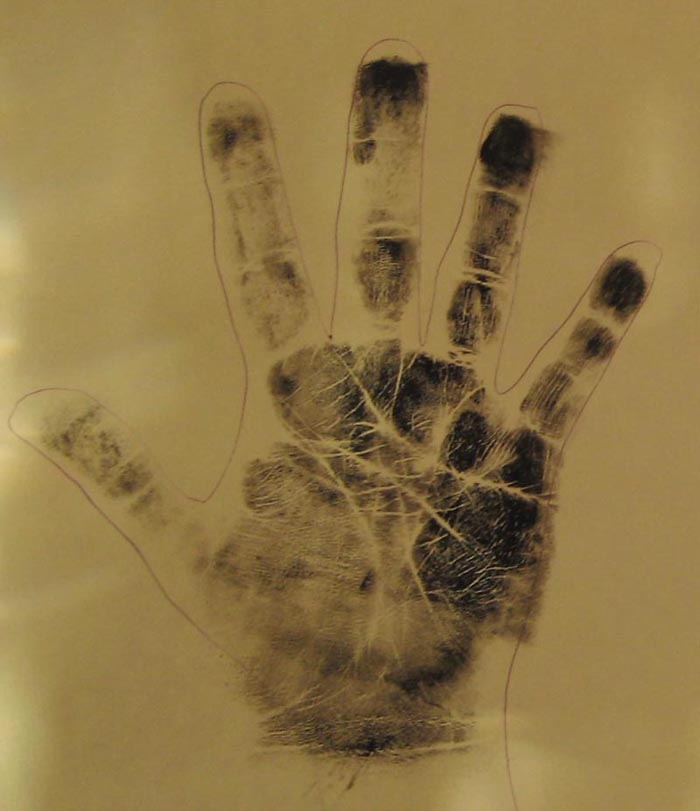 Creating a Palm Print
Creating a Palm Print

White space reference change
Tools to create a palm print
black Speedball water soluble ink
one inch ink roller
paper plate
pen
paper (File folder is best)
I create a palm print for each client I read. This is how it's done.
The client washes their hands thoroughly to remove excess oil or other
creams they may have applied to their hands before coming here. A clean
dry hand is best.
Place a small amount of ink on the paper plate and run the roller over
the ink until the roller is totally covered. Sometimes the ink is thick
so run it across another piece of paper to thin it out.
Roll the ink onto the palm making sure the hand is evenly covered.
Place the palm onto the paper.
Outline the hand using a pen.
Do not move the hand.
Hold the palm in place. Press firmly then slowly slide the palm and paper to the edge of the table.
Holding the palm in place, slide the paper and palm off the table
pressing your hand under the paper then pressing on the palm from
beneath to capture all of the lines.
Carefully slide the paper and palm back onto the table and move across
the fingers from side to side making sure everything has been pressed
into place. (Some clients comment that it feels like a hand massage.)
The client lifts their hand from the paper and the palm print is ready.
I repeat this twice as each palm print will be different. The second
copy will be lighter as I don't use any more ink. Light sections denote
changes.
The client washes their hands and I label everything on the palm chart. We are now ready to discuss what it says.
Use a magnifying glass to look at different areas to bring out images not seen with the naked eye.
Use the palm of the dominate hand only.
 There
has never been conceived or made by man any instrument, machine, or
contrivance, capable of such a diversity of usefulness as the human
hand.
There
has never been conceived or made by man any instrument, machine, or
contrivance, capable of such a diversity of usefulness as the human
hand.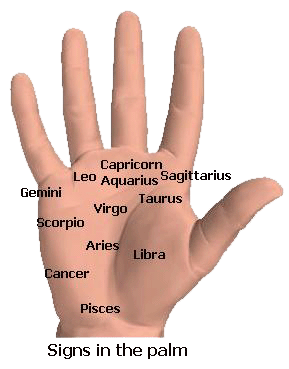
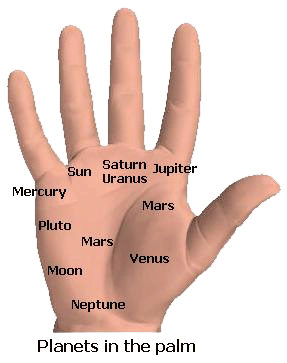
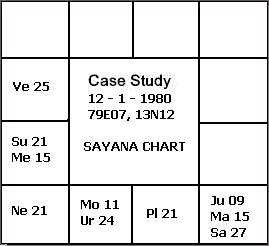
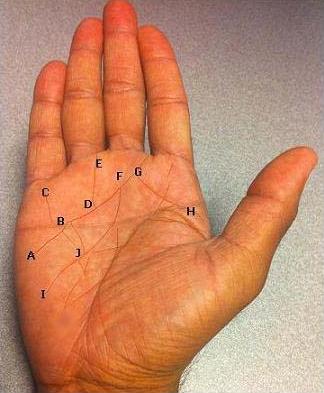
 But many of us do not know the other side of Pythagoras. Born in 570 BC
in Samos, Pythagoras was an Astrologer, Numerologist, Musician and a
spiritual Guru.
He was able to communicate with Siddhas (enlightened souls) and went
back into his past births and visualized his ninety nine thousand past
lives in a row. He was able to predict earthquakes and calm the waves of
the seas and rivers while travelling on. He healed several people with
his music by playing lyre. After getting enlightenment, he started his
own school where he used to teach Numerology and philosophy to his
students. While initiating his students, he used to give a secret mantra
(sacred sound) to his disciple.
But many of us do not know the other side of Pythagoras. Born in 570 BC
in Samos, Pythagoras was an Astrologer, Numerologist, Musician and a
spiritual Guru.
He was able to communicate with Siddhas (enlightened souls) and went
back into his past births and visualized his ninety nine thousand past
lives in a row. He was able to predict earthquakes and calm the waves of
the seas and rivers while travelling on. He healed several people with
his music by playing lyre. After getting enlightenment, he started his
own school where he used to teach Numerology and philosophy to his
students. While initiating his students, he used to give a secret mantra
(sacred sound) to his disciple.  He also mentioned that some numbers carry karmic debts, i.e. the
results of bad actions done in previous births, into the present lives
of the people. Plato followed Pythagoras philosophy. Iamblichus gathered
his verses and Thomas Taylor translated them from the Greek.
He also mentioned that some numbers carry karmic debts, i.e. the
results of bad actions done in previous births, into the present lives
of the people. Plato followed Pythagoras philosophy. Iamblichus gathered
his verses and Thomas Taylor translated them from the Greek. 





